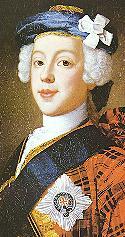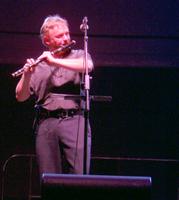Every time I play this tune I ask what I've gotten myself into. With four parts, and some tricky fingerings, it's the hardest tune I play right now. That it lends itself well to speed doesn't help matters much. My teacher says it's a good tune for me to practice as it will help me clean up note transitions which involve moving most or all of my fingers at once, since there are a lot of those in this tune.
It's also a lot of fun to listen to. The Tannahill Weavers have an unusual but excellent arrangement where they play the tune through once, then sing Johnny Cope, then play the Atholl Highlanders again. You can hear this on their albums "Tannahill Weavers IV" and "Best of 1979-1989."
I couldn't find a transcription I liked (read: one which sounded like what The Tannahill Weavers and my local session play), so I ended up making my own. It's a combination of ideas and phrases used in the following versions, plus what I hear on the cited recording:
- Scots Guards, Volume 1
[PDF]. In general when playing pipe tunes I like to look at the GHB scores. Note that GHB scores have no key signature since A mixolydian is the only choice on that instrument. - This transcription for tin whistle by Gregory Mahan.
- This transcription by Henrik Norbeck.
Those who like dots can cut and paste this into Concertina.net's ABC Convert-A-Matic.T:Atholl Highlanders, The R:march M:6/8 K:A mix X:1 |:e3 ecA|ecA Bcd|e3 ecA|Bcd cBA| e3 ecA|ecA Bcd|eae fed|cdB A3:| |:Ace Ace|Bdf Bdf|Ace Ace|Bcd cBA| Ace Ace|Bdf Bdf|eae fed|cdB A3:| |:a2e edc|a2e edc|a2e edc|Bcd cBA| a2e edc|a2e edc|eae fed|cdB A3:| |:cAc cAc|dBd dBd|cAc cAc|BGB BGB| cAc cAc|dBd dBd|eae fed|cdB A3:|
Since this is a pipe tune I'm using cuts instead of tonguing to separate the (many) repeated notes. My teacher thinks this is excellent cut practice but too much from a listening point of view. I think it makes it sound more "bagpipey." There's probably a happy medium somewhere, but I don't have any recordings of the tune played on tin whistle for reference.
One of the fiddlers in my session plays an interesting variation in the last part. In the fourth measure of that part, he plays B2 B2 B2 instead of BGB BGB. This has the effect of disrupting the march beat and sounds pretty nice when only one person plays it and the rest of the session plays the tune as usual. However, it's too much, in my opinion, when the entire session plays that variation, in part because it's too disrupting to the beat and in part because it gets rid of the G natural, which gives the mixolydian mode its distinctive sound.
Despite being in 6/8 this is a march and not a jig, so it should have a march beat instead of a jig rhythm. I suppose you could play it as a jig if you wanted to, though.
Music theory geek digression: You occasionally see this tune scored in A major with accidental naturals on the Gs. I think that's incorrect, although I've seen an argument for the practice. Since we use the two-sharps key signature for tunes in E dorian, why use three for A mixolydian, which uses precisely the same notes?




